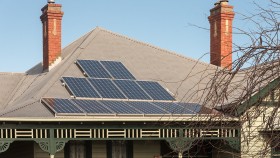New study reveals secrets to solar success
A new study shows how researchers at The Australian National University (ANU) achieved a world record in solar cell efficiency.
The study focused on perovskite solar cells - made using a special group of materials which are cheap and easy to manufacture.
The group achieved 21.6 per cent efficiency in converting sunlight into electricity, a new record for perovskite solar cells larger than one square centimetre in size.
According to lead researcher Associate Professor Tom White, they managed to achieve this breakthrough by adapting a technique which has already proven successful with silicon solar cells.
"A common problem with solar cells is that any defects in the cell can trap electrons, taking away the energy they gained by absorbing sunlight," Associate Professor White said.
"A way around this is to "passivate" the surface by coating the light absorbing material with a thin layer of another material to reduce defects. But the materials used to reduce defects are often poor conductors of electricity.
Dr Jun Peng, who proposed the solution to this problem, explained that "some silicon cells use holes to let the electrons through this insulating layer, creating a kind of conductive pathway. We decided to take a similar approach with our perovskite cells."
"The idea behind it and the reasons it works are the same, but our models showed us that to make it work on perovskite solar cells, we would need to manufacture these holes on the scale of nanometres - thousands of times smaller than is used in silicon," Dr Peng said.
"Thus, instead of holes, we used nanoscale rods that poke through the insulating layer."
This is the first time this technique has been applied to perovskite cells, so the researchers used computer simulations to prove it worked.
"Computer models are really useful in a study like this," Dr Daniel Walter, who led the modelling work on the project, said.
"Once you have made a solar cell it can be difficult to probe inside them to see what is happening. We were able to simulate what was happening inside the cells to explain how the nanorods improved the cell performance."
The team's record result was independently verified by the CSIRO Photovoltaics Performance Lab.
"We'll continue to work to achieve even higher efficiencies with perovskite," Associate Professor White said.
"Silicon will reach its upper limit of efficiency very soon, so we see these perovskites cells as the way forward."
This study was completed with the assistance of Australian Renewable Energy Agency funding.
The research has been published in the journal Science.











